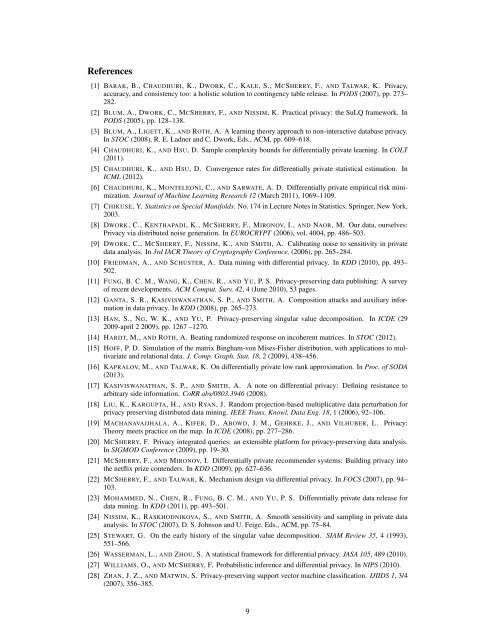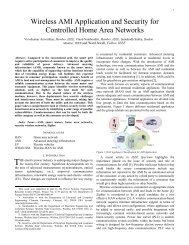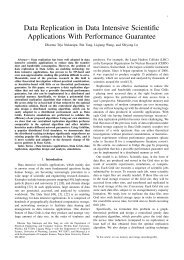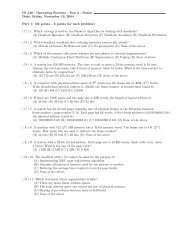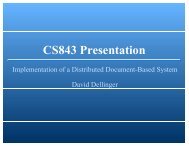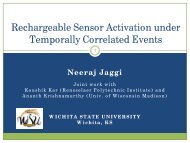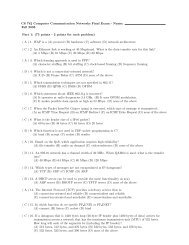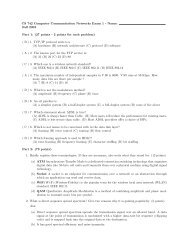Near-optimal Differentially Private Principal Components - NIPS
Near-optimal Differentially Private Principal Components - NIPS
Near-optimal Differentially Private Principal Components - NIPS
Create successful ePaper yourself
Turn your PDF publications into a flip-book with our unique Google optimized e-Paper software.
References[1] BARAK, B.,CHAUDHURI, K.,DWORK, C.,KALE, S.,MCSHERRY, F., AND TALWAR, K. Privacy,accuracy, and consistency too: a holistic solution to contingency table release. In PODS (2007), pp. 273–282.[2] BLUM, A.,DWORK, C.,MCSHERRY, F.,AND NISSIM, K. Practical privacy: the SuLQ framework. InPODS (2005), pp. 128–138.[3] BLUM, A.,LIGETT, K.,AND ROTH, A. A learning theory approach to non-interactive database privacy.In STOC (2008), R. E. Ladner and C. Dwork, Eds., ACM, pp. 609–618.[4] CHAUDHURI, K.,AND HSU, D. Sample complexity bounds for differentially private learning. In COLT(2011).[5] CHAUDHURI, K.,AND HSU, D. Convergence rates for differentially private statistical estimation. InICML (2012).[6] CHAUDHURI, K.,MONTELEONI, C.,AND SARWATE, A. D. <strong>Differentially</strong> private empirical risk minimization.Journal of Machine Learning Research 12 (March 2011), 1069–1109.[7] CHIKUSE, Y.Statistics on Special Manifolds. No. 174 in Lecture Notes in Statistics. Springer, New York,2003.[8] DWORK, C.,KENTHAPADI, K.,MCSHERRY, F.,MIRONOV, I.,AND NAOR, M. Our data, ourselves:Privacy via distributed noise generation. In EUROCRYPT (2006), vol. 4004, pp. 486–503.[9] DWORK, C.,MCSHERRY, F.,NISSIM, K.,AND SMITH, A. Calibrating noise to sensitivity in privatedata analysis. In 3rd IACR Theory of Cryptography Conference, (2006), pp. 265–284.[10] FRIEDMAN, A.,AND SCHUSTER, A. Data mining with differential privacy. In KDD (2010), pp. 493–502.[11] FUNG, B.C.M.,WANG, K.,CHEN, R.,AND YU, P. S. Privacy-preserving data publishing: A surveyof recent developments. ACM Comput. Surv. 42, 4 (June 2010), 53 pages.[12] GANTA, S.R.,KASIVISWANATHAN, S.P.,AND SMITH, A. Composition attacks and auxiliary informationin data privacy. In KDD (2008), pp. 265–273.[13] HAN, S.,NG, W.K., AND YU, P. Privacy-preserving singular value decomposition. In ICDE (292009-april 2 2009), pp. 1267 –1270.[14] HARDT, M.,AND ROTH, A. Beating randomized response on incoherent matrices. In STOC (2012).[15] HOFF, P. D. Simulation of the matrix Bingham-von Mises-Fisher distribution, with applications to multivariateand relational data. J. Comp. Graph. Stat. 18, 2 (2009), 438–456.[16] KAPRALOV, M.,AND TALWAR, K. On differentially private low rank approximation. In Proc. of SODA(2013).[17] KASIVISWANATHAN, S.P., AND SMITH, A. A note on differential privacy: Defining resistance toarbitrary side information. CoRR abs/0803.3946 (2008).[18] LIU, K.,KARGUPTA, H.,AND RYAN, J. Random projection-based multiplicative data perturbation forprivacy preserving distributed data mining. IEEE Trans. Knowl. Data Eng. 18, 1 (2006), 92–106.[19] MACHANAVAJJHALA, A.,KIFER, D.,ABOWD, J.M.,GEHRKE, J., AND VILHUBER, L. Privacy:Theory meets practice on the map. In ICDE (2008), pp. 277–286.[20] MCSHERRY, F. Privacy integrated queries: an extensible platform for privacy-preserving data analysis.In SIGMOD Conference (2009), pp. 19–30.[21] MCSHERRY, F.,AND MIRONOV, I. <strong>Differentially</strong> private recommender systems: Building privacy intothe netflix prize contenders. In KDD (2009), pp. 627–636.[22] MCSHERRY, F.,AND TALWAR, K. Mechanism design via differential privacy. In FOCS (2007), pp. 94–103.[23] MOHAMMED, N.,CHEN, R.,FUNG, B.C.M.,AND YU, P. S. <strong>Differentially</strong> private data release fordata mining. In KDD (2011), pp. 493–501.[24] NISSIM, K.,RASKHODNIKOVA, S.,AND SMITH, A. Smooth sensitivity and sampling in private dataanalysis. In STOC (2007), D. S. Johnson and U. Feige, Eds., ACM, pp. 75–84.[25] STEWART, G. On the early history of the singular value decomposition. SIAM Review 35, 4 (1993),551–566.[26] WASSERMAN, L.,AND ZHOU, S. A statistical framework for differential privacy. JASA 105, 489 (2010).[27] WILLIAMS, O.,AND MCSHERRY, F. Probabilistic inference and differential privacy. In <strong>NIPS</strong> (2010).[28] ZHAN, J.Z.,AND MATWIN, S. Privacy-preserving support vector machine classification. IJIIDS 1, 3/4(2007), 356–385.9


